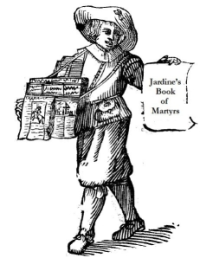Major Winram and the Dispute over the Parks of Baldoon
On 15 July, 1686, Lord Fountainhall notes a petty dispute before the Privy Council that involved Major Winram, the man that Presbyterian sources allege hanged three men at Wigtown…
‘[Sir David] Dumbar of Baldum gives in a complaint against Major Winrahame, that he had quartered his troup on his very meadows and inclosed ground, contrare to the priviledge given by the Act of Parliament in 1661, to parks: Which Duke of Hamilton being preses judged illegall; but he had got Baldun’s grandchild espoused to one of his sones; but George Winraham told the Duke, he would take bad language from no subject.’ (Lauder, Historical Notices, II, 744.)
Baldoon Castle © Andy Farrington and licensed for reuse.
Sir David Dunbar of Baldoon (1610–1686) lived in Kirkinner parish. His house, Baldoon Castle, lay just across the Bladnoch from Wigtown. The impressive ruins of the seventeenth-century house lie beside Baldoon Mains.
The dispute centred on Winram’s use of Dunbar’s inclosed park and meadows at Baldoon for the military purpose of quartering his dragoons and providing grazing for the horses.
Mary Dunbar, ‘the granddaughter, and heiress, of Sir David Dunbar of Baldoun’, later carried the estate ‘by marriage, to Lord Basil Hamilton, sixth son of William, and Anne, the Duke, and Duchess, of Hamilton’. (History of Galloway, 183n.)
Dunbar appears to have been sympathetic to the Presbyterian cause at the time of the Bothwell Rising in 1679, but by 1685, he was involved, like other moderate presbyterians, in pressing the Abjuration oath against the Society people.
Through apparent loyalty to the regime, his portfolio of estates expanded in Galloway. At some point after 1682, he acquired Glengap in Twynholm parish, the home of the martyr, David Halliday in Glengap.
Dunbar also obtained the lands of Kilsture in Kirkinner parish, which had been the home of the Societies’ activist, Alexander Gordon of Kilsture.
Both the estates of Baldoon and Kilsture lay close to Drumjargon, the home of Margaret McLachlan, one of the two women drowned at Wigtown. McLauchan was a tenant of Alexander Vaus, laird of Barwhanny, and his wife, Margaret Maxwell. The latter was recorded as disorderly on the parish list of 1684, as was Grissel Vaus, possibly their daughter, and a second Margaret Maxwell, who was scrouged through the streets of Wigtown at the time of the martyrs’ alleged execution.
It is alleged that Major Winram was involved in drowning of Margaret McLauchlan in May, 1685. The evidence of the dispute between Dunbar and Winram does place Winram and his dragoons at Baldoon in Kirkinner parish and at Wigtown in the year after the drownings.
Text © Copyright Dr Mark Jardine. All Rights Reserved. Please link to this post on Facebook or retweet it, but do not reblog in FULL without the express permission of the author @drmarkjardine
Related
~ by drmarkjardine on November 17, 2014.
Posted in Alexander Gordon of Kilsture, Alexander Vaus of Barwhanny, Captain 'Major' George Winram, Covenanters, David Dunbar of Baldoon, David Halliday in Glengap (d.1685), Galloway, His Majesty's Regiment of Dragoons, Kirkinner parish, Margaret Maxwell, Margaret McLachlan (d.1685), Scotland, Scottish History, Wigtown, Wigtownshire
Tags: Baldoon Castle, Covenanters, Galloway, History, Scotland, Wigtown
4 Responses to “Major Winram and the Dispute over the Parks of Baldoon”
Leave a comment Cancel reply
This site uses Akismet to reduce spam. Learn how your comment data is processed.




[…] Complaints about the quartering of Winram’s dragoons also came from Baldoon, on the south side of the River Bladnoch. […]
Three Men Hanged?: Major Winram in Wigtown at Lambas, 1685 | Jardine's Book of Martyrs said this on June 2, 2015 at 4:10 pm |
[…] that the garrison there predated the arrival of Major Winram’s dragoons in the area, as they were quartered at Baldoon and around Wigtown. Baldoon lay in McLachlan’s home parish of Kirkinner. If the area had been […]
The Wigtown Martyrs: The Record of Kirkinner Kirk Session, April, 1711 | Jardine's Book of Martyrs said this on June 10, 2015 at 11:27 am |
[…] The name of one of the two witnesses to the petition may also appear in the Wigtownshire parish lists of October, 1684. It is not clear who the witnesses were, unlike Moir, but one candidate is perhaps the ‘William Gordon’ recorded on the parish list for the burgh of Wigtown with other Gordons below the name of Baillie Alexander Gordon. Dunbar is also a Wigtownshire name. Is the latter close to David Dunbar of Baldoon, of the same Kirkinner parish where McLachlan lived? His name takes precedence in the list of two witnesses. Baldoon clearly had presbyterian connections. Is this petition an arms-length attempt by some Presbyterians in the local elite to intervene? Dunbar would later appeal to the Privy Council that Winram, who later conducted the execution of the two women, had quartered his dragoons on his meadows. […]
The Wigtown Martyrs: The ‘Petitione for Margaret Lachlisone’ of 28 April, 1685 #History #Scotland | Jardine's Book of Martyrs said this on May 13, 2020 at 11:34 pm |
[…] in 1686, David Dunbar of Baldoon petitioned the privy council about prior losses due to Winram’s men quartering in the parks of his […]
The Wigtown Martyrs: Touching the Void between the Reprieve and Execution in 1685 #History #Scotland | Jardine's Book of Martyrs said this on June 28, 2020 at 6:02 pm |